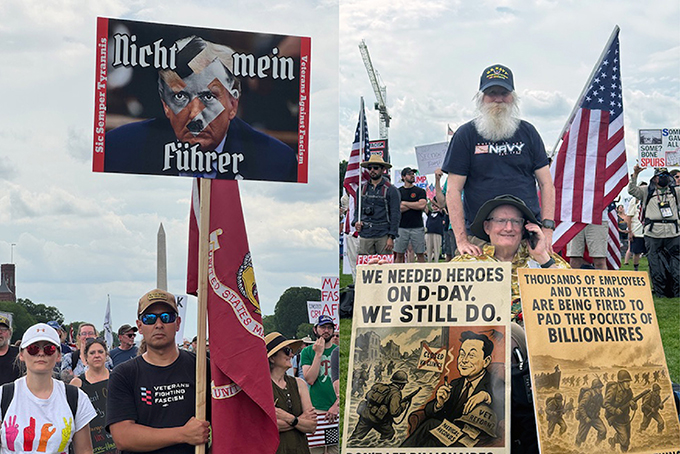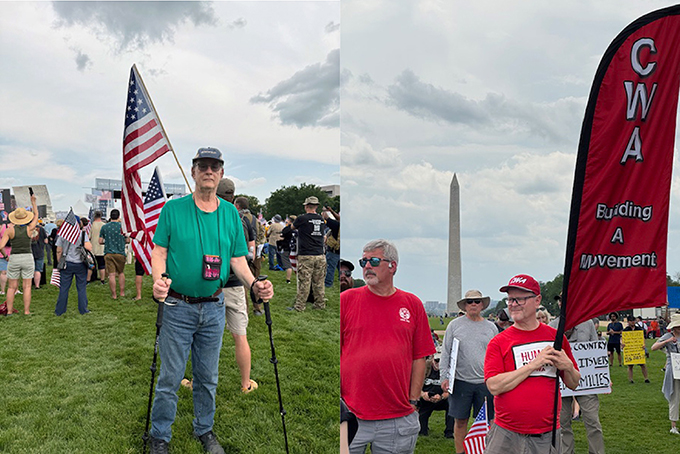The Power of Showing Up
By Evie Frankl, Steve Early and Suzanne Gordon
“A lot of the people I served with are 100 percent disabled. What if they lose their care? What if they served the country but can now no longer make ends meet?” Reed Radcliffe, 68, who spent two decades in the Navy, told the Washington Post on June 6th, 2025
I’m Evie Frankl
I took the pics at the “Unite All Vets” demo on the National Mall in DC today, the 6th of June 2025.
It was great to be in such a politically, demographically and multigenerational crowd. People were eager to have their photos sent so I texted or email each one.
Drop Kick Murphy played lots of raucous rock versions of old favorites including Which Side are you On and We Shall Overcome.
We heard Cecil Robert’s (UMW).
Big crowd, great weather, lots of flags, angry Republicans
What could be better?
Defending VA Veterans Health Care on D-Day – Thousands of veterans mobilize to oppose the gutting of direct care and the move toward privatization.
By: Suzanne Gordon and Steve Early
The D-Day anniversary on June 6 is a pretty irresistible date for scheduling a protest related to veteran benefits. Eighty-one years ago, American soldiers and their allies stormed ashore in Normandy, establishing a critical beachhead in the military campaign to defeat Adolph Hitler and Nazism.
In World War II’s aftermath, hundreds of thousands of injured veterans were treated back home in a nationwide network of hospitals run by the federal government. Since then, the VA health care system has greatly expanded, and now through the Veterans Health Administration (VHA) provides high-quality care to nine million veterans. The majority of those veterans want to see the VHA improved and even expanded.
However, during the first Trump administration, the White House and a bipartisan coalition in Congress decided that veterans’ health care delivery needed to shift to the private sector. After passage of the VA MISSION Act of 2018, Trump’s second VA Secretary, Robert Wilkie—a right-wing southern Republican—claimed that partial VHA privatization would produce “more patient satisfaction and predictability, more efficiency for our clinicians, and better value for taxpayers.”
Using D-Day as a protest peg six years ago, a few veterans and their caregivers challenged this view. Members of the American Federation of Government Employees (AFGE), National Nurses United (NNU), and Veterans for Peace (VFP) staged a “National Day to Save The VA” from privatization. That resulted in modest rallies, press conferences, or informational picketing in only a dozen locations, because the grassroots effort drew little or no support from major veterans’ organizations, the national AFL-CIO, or big-name politicians.
A Renewed Assault
President Trump’s second-term assault on all services provided by federal workers—along with their jobs and bargaining rights—has finally woken up more unions and veterans’ advocates to threats that have faced the VA for more than a decade.
On June 6, 5,000 protestors gathered on the Mall in Washington, D.C., under the banner of Unite for Veterans /Unite for America. The event was sponsored by the Union Veterans Council of the national AFL-CIO and the Chamberlain Network, a non-profit group that hopes the rally will “encourage the administration to make the right decisions for veterans.”
Former service members, including some who belong to AFGE, NNU, National Federation of Federal Employees, and other unions, heard speeches from past or present vets in Congress like Sen. Tammy Duckworth (D-IL) and former Republican House member Adam Kinzinger (R-IL), who became a major Trump critic during his first term.
Thousands of people also participated in actions at 225 other locations around the country, including in vet-heavy red states like Alaska, Alabama, Florida, Georgia, North Carolina, Idaho, Kansas, and Kentucky. Some “watch parties,” organized for real-time viewing of the D.C. event, were held in local union halls to highlight the labor-vet overlap. The grassroots political organization Indivisible was a local partner as well.
The livestream from D.C. was greatly enlivened by the Dropkick Murphys, a group of Celtic punk rockers from Boston who Union Vets Council leader William Attig regularly listened to as an 18-year-old Marine in Iraq.
This pro-labor band got wild applause after performing a new release well suited to the occasion. Its chorus, as belted out by lead singer Ken Casey, asked: “Who’ll stand with us? / Don’t tell us everything is fine / Who’ll stand with us? / Because this treatment is a crime.”
Everything is Fine?
In the run-up to this D-Day, President Donald Trump’s current VA Secretary Doug Collins—like Robert Wilkie before him—has been telling nine million VHA patients that everything is fine, not a crime, despite his planned elimination of more than 80,000 VA jobs later this year.
According to Collins, a former Republican House member from Georgia, Trump “is making it even easier for veterans to get their health care when and where it’s most convenient for them” by letting them choose between in-house doctors and faster referrals to a nationwide network of 1.7 million private-sector providers. Collins’s proposed budget for fiscal year 2026 clearly favors the latter; it calls for a 50 percent increase in VHA spending on outside care (which already totals $30 billion a year) and an unprecedented 17 percent reduction in direct-care funding.
Since this budgetary math would force cuts to VHA staff, services, and facilities, one purpose of the D-Day rally in D.C. was to sound the alarm about Trump’s renewed privatization push. A speaker who did that very movingly was 43-year-old Matt Stevenson, a primary care physician at the VA Medical Center in Palo Alto.
Making it clear he was speaking in a personal capacity, Stevenson lauded his employer as “a mission-driven, patient-centered, cost-effective, integrated American health care system … which delivers higher-quality care at lower cost than any other system in the country.”
According to Stevenson, under a DOGE-led assault since January, his coworkers around the country have “been disparaged and demoralized … bullied and intimidated” amid “worrisome signs of an attempt to dismantle and privatize the VA.” He argued that “those who would take this public treasure—built over generations, by many hands, working long nights in dark hospitals—and sell it off in the name of choice or modernization or efficiency or political gain” can be stopped if VA defenders “come together around a shared vision.”
Caregivers Quitting
One of the things that inspired some veterans to attend events was learning that their doctors, nurses, or therapists were quitting due to deteriorating workplace conditions under Collins.
David Magnus, a Navy veteran from Pittsburgh, told The Guardian that he traveled to D.C. because his trusted provider revealed her decision to leave the VHA during a recent mental health appointment. Outside a Veterans Memorial Building in San Rafael in northern California, Katie Weber-Linhar, an Army veteran with disabilities, lamented the recent resignation of a popular therapist who treated many vets at an outpatient clinic in Ukiah, in rural Mendocino County.
Weber-Linhar now helps a retired VHA physician hold a weekly protest, attended by patients, family members, and local union members, at a VA outpatient clinic in Santa Rosa, in Sonoma County. She and other VA defenders definitely did not get the memo from D.C. rally planners, which stressed that “Unite for Veterans” was not intended to be “an anti-Trump event or a partisan protest.”
Handmade placards in Santa Rosa included one dissing DOGE as a bunch of “Douchebag Oligarchs Grabbing Everything” and others identifying the sign-holder as a “Veteran Against Trump” and critic of “Trump’s America” because of its “Cages for Kids, Cuts for Vets.” Ernie Bergman, a cancer survivor and 77-year-old leader of Vietnam Veterans of America (VVA) in Marin County, criticized “this current government” for trying to take money away from medical research and innovative treatment “that saved my life.”
VSOs Were MIA
Iraq combat veteran Kristofer Goldsmith, a former staffer for the Vietnam Veterans of America turned podcaster and founder of Task Force Butler, said he was thrilled that “people at the protest in Washington were not the usual suspects. I had people come up to me who had flown in from every part of the country who had never been at a protest before but who wanted to be part of something historic.”
Goldsmith noted, however, that some groups were notable for their official absence—representatives of the “big six” veteran service organizations. Just a few months ago, Goldsmith was much encouraged when the national commander of one of these VSOs—the Veterans of Foreign Wars (VFW)—urged his 1.4 million members to “march forth” and “stop the bleeding” at the VA. As a life member of the VFW but past critic of overly cautious and conservative VSO behavior, Goldsmith viewed this development as “nothing short of extraordinary.”
On D-Day, however, the VFW, American Legion, and other major vet groups were MIA. According to Goldsmith, there were VSO members at the D.C. rally “in a personal capacity,” but there was no official staff or representation of the “big six.” In Goldsmith’s view, if the big VSOs “were making enough noise and standing up to the cuts in a way that reflects the urgency of the moment, they would have been on the stage with us.”
William Attig, the Union Vets Council leader and a key rally organizer who served in both Iraq and Afghanistan before joining a plumbers and pipefitters local in Illinois, said that organizers were working with the VSOs “behind the scenes.” Hopefully these efforts will convince major VSOs to end, what one concerned representative described to the Prospect as their deafening silence on Trump/DOGE/Collins assault on veterans, their dedicated caregivers, and their hard-earned benefits.
The Next Step
The question is what’s next. Attig, among other organizers and attendees, emphasized that this event will be only one of many. It was a “very exciting event that shows what can happen when veterans come together around their issues.”
James Jones, a Gulf War veteran from Boone, North Carolina, who is also a federal employee with the National Park Service, a member of AFGE and of the newly formed Federal Unionists Network, could not agree more. In a post D-Day protest interview with the Prospect, Jones said he traveled from North Carolina to the event because he wants legislators to understand how important the VA has been to veterans like himself.
“I lost friends during the Gulf War, and I’ve dealt with health issues because of exposure to… you name it,” Jones said. “Airborne toxins, oil well fire smoke, burn pits, depleted uranium residue. I’ve been a VA patient since 1993 and the VA has been beneficial to me because they understand PTSD, military trauma, and everything else.”
Jones said he hopes that veterans will keep up the pressure. “We have to call our elected representatives, keep going to rallies, and join these groups that are fighting for veterans. Secretary Collins is trying to convince people that the VA is a bloated agency. It’s not—they’re thousands of positions short. The government needs to keep the promise it made to veterans. We served our country and now they’re breaking their promise to take care of us. We can’t accept that.”
…
The piece by Steve Early and Suzanne Gordon originally ran in The American Prospect
On June 14th, this Saturday, it’ll be time for all of us to show up around the country. Check out sites here
…



